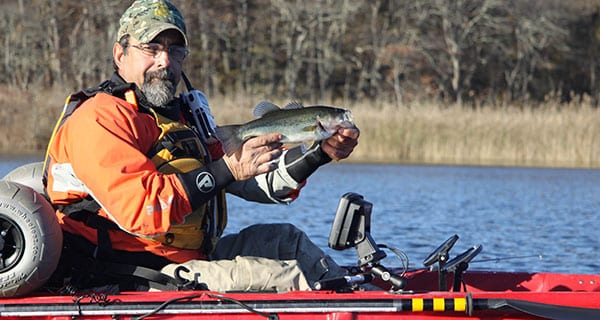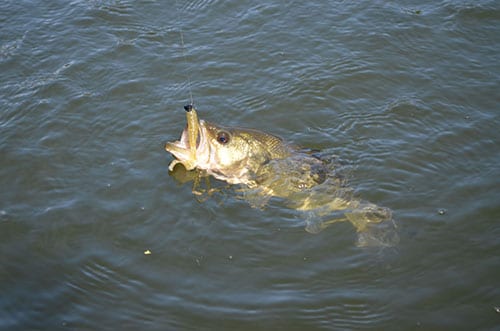
By Tom Schlichter
Just because the thermometer reads 35 degrees outside doesn’t mean you can’t catch largemouths. No doubt, it takes more work and preparation than summertime casting, but the past few years has seen a significant improvement of cold weather open water success rates.
I’ve heard it said many times by bass fans – especially here in the Northeast – that there’s no point to bassin’ during January and February because the fish “just don’t eat much.” But, then, how do you explain the ones caught by accident while ice fishing? Perch, crappies, sunfish, pickerel and trout all feed under the ice. So, too, do carp, catfish, eels and even shiners. Cold or not, bass have to eat – and I suspect they feed more frequently during the winter than most anglers believe.
Okay, then, where to start? Well, let’s tackle the where to find ‘em end of things first. As a rule, the best jump off point is to look in deep water. At this time of year, largemouths want to hold in the warmest temperatures available. Often, but not always, this means they’ll be found in deep pockets. Here, they’ll gain a degree or two over shallow water environs while being protected from radical temperature shifts by the buffering effect of several feet of liquid above their heads. I’ve caught winter bass in as little as four feet of water, but I’ve scored far better when working eight to 12-foot depths and even on out to 20, 30 and even 40 feet of water. Finding such holes or channels in an area that receives plenty of sun also seems to help. The last thing that winter bass need at this time of year is heavy shade.
To apply a deepwater approach on a local scale, you need to determine exactly what “deep” means on the lakes, ponds and rivers you fish. For example, deep water in large lakes or rivers might be 12 to 20 or more. Deep water at your local mill pond might be six to eight feet. It’s all relative. Personally, I find it easier to score on the larger, deeper, lakes as the bass spook easily in shallow environs. Thus, I tend to work lakes renown as deep water producers. That same drop-off or ledge which holds a few lunkers in the heat of August is likely to produce again in January, February and March. Work those dawg-day honey holes and check current contour maps for additional ledges, pockets, old creek beds, depressions and structure you may have over-looked during the summer season.

Assuming that you now have a bead on some potential fish holding water, the next logical question is how to turn on the fish. When it comes to technique, there are two approaches that I’ve stumbled upon which seem to work with a fair degree of consistency during the winter months. Both are light-tackle finesse presentations made with four to six-pound test spinning gear.
My go to approach is to toss small, curly-tail grubs impaled on light-weight leadhead jigs. Berkley Power Grubs are great for this with white as my first choice but I do favor a three-inch Kalin Lunker Grub in smoke/red flake if the bite during noticeable warming trends. I like to drift these drift these lures slow and steady across the bottom with almost little imparted action save for a light skip now and then. Think of this presentation as an exaggerated glide rather than a jigging motion. Strikes are generally light this time of year, often registering as little more than a little extra weight at the end of the line.
Under ideal conditions, i.e., a slightly overcast sky and little or no wind, this rig can be drifted across the bottom until it picks up a little bit of grass or takes on a fish. Lower the bait gently until you feel bottom and then crank up three turns of the reel handle to keep it just above. Feel constantly for the bottom and adjust your line up or down to keep your offering within two feet of the bottom. Once you’ve drifted over a promising spot two or three times with the line down deep, crank it up a few more turns so it rides three to four feet off the bottom.
Another option that can work well, especially when fishing over stumps or downed timber, is vertical jigging. This, however, takes a lot of patience and the ability to hold a boat in position directly over a selected target. For this approach, I like to use a small Swedish Pimple – the same one used for ice fishing. Work this lure in a straight up and down fashion as you hold steady over prime territory and you may be pleasantly surprised. Tipping the lure with a small piece of garden worm, mealy worm or spike, as you would when ice fishing, adds a little scent seems to draw more strikes – although it also increases the ratio of panfish to bass with which you’ll connect.
Of course, this being winter, there’s no counting on calm days. Wind can be a tough factor with which to deal. If it’s blowing out, drop over an anchor, cast out from the boat, and work your line slowly back along the bottom. Once again, slow and steady is the key. Work hard to eliminate from your retrieve the herky-jerky movements that bass normally find enticing during the summer months, glide your lure along and set the hook with a smooth, firm lift of the rod.









